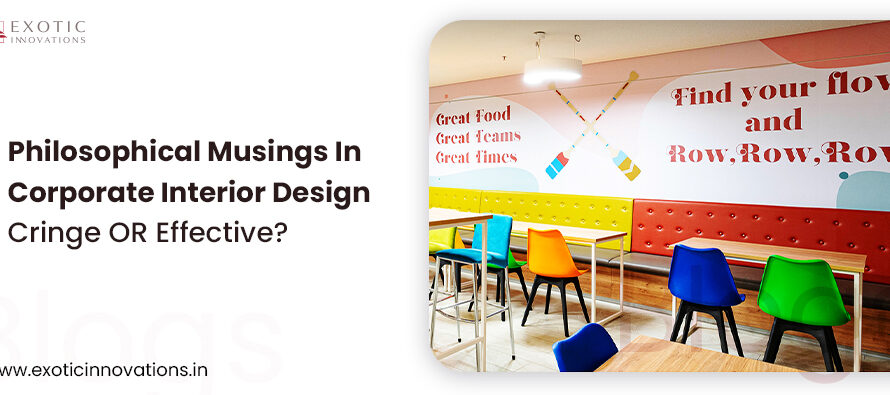The way we work has seen significant changes over the span of the last three years. The Coronavirus, Mental Health spotlight, and the mass retreat to offices have forced companies to rethink their workspaces that prioritize productivity, mindfulness, and work-life balance. Work from home is much faster and quite suitable for work that doesn’t require collaboration and for which minimum authorization is sufficient. Through work from home, one realized that a major chunk of their to-do list can be done from home itself, and they could save on commute time. However, many employees, after their brief stint at their home offices with teeming backgrounds and distractions abound found that they miss their office and the social interactions they had with their colleagues. Meetings over Zoom were convenient, yes, but the limited body language gave way to misinterpretation and misunderstandings. Usually, in offices, one could just pop by a superior’s desk and clarify any doubts about a project or while making a beeline to get coffee, correct an intern or a junior employee.
All these touches of social interaction and collaboration were massively hurt, and employees, even the introverted ones, thought the work from home was a ticking time bomb.Now that employees want to come back to the office and have ideation sessions, the onus lies on the company to remodel its workspace because how employees work has changed substantially. They have different expectations reverting to office, and if they are given the same pre- 2020 environment to work in, the company can expect two-digit attrition rates. According to research by Microsoft, 66% of the worldwide companies are redesigning their workspaces to incorporate hybrid work, biophilic elements, and modern designs based on research on workspace designs.
1. Ask your employees what they want: This is the safest and most decentralized method of making a critical decision on workspace design. Through surveys, interviews, trial services, and periodic feedback, managers, and executives are always on their feet, and can effectively remodel workspace design to suit the evolving needs of the modern work environment. Just categorizing workers as – in office’, ‘hybrid’ and ‘remote’ is not enough. It overlooks the complexities of human nature and is a superficial understanding of work styles. Understanding the distribution of your employees’ work styles is key to developing resilient office design solutions that meet the evolving needs of your employees.
2. Divide the remodeling into phases: Returning from work from home to traditional offices will take some time, and initial inhibitions will be there but this entire process can be less overwhelming if it is done in phases. The first phase- revert will focus on gathering ideas for the new workspace, testing its feasibility, and setting the stage for the return. The next phase – development will put these ideas into implementation and design new workspaces, strip the unproductive elements and add biophilic elements. The development phase is succeeded by an evolution phase where new designs and elements are ingrained in the office culture as employees become habitual to them. It also entails feedback loops for constant improvement of the workspace.
For an instance, companies are getting rid of open-plan offices and opting for collaborative workspaces, private, cozy, and acoustic spaces for focussed work, and common areas for a non-focused and diffused discussion. The open-plan offices are overrated and hinder productivity as they foster contagious diseases and create a very synthetic environment. This is the revert phase where ideas can be discussed.Now, to put all of this into action is a different ball game altogether.The incorporation of natural elements and new ideas was done in a wonderful fashion by the International Olympic Committee when it opened its new headquarters in Lausanne, Switzerland. The office right in the center of a busy floor had stairs leading up to it in the form of the Olympic rings and at every break had comfy couches and high-end tables where personnel from different departments could chat and discuss ideas.
What a beautiful, symbolic and innovative idea!Lastly, the evolution phase is where companies fail. Workspace design is a continuous process and even the best of the ideas implemented well will go awry if the employees don’t feel comfortable and their feedback isn’t valued.
3. Prioritize wellness of employees: Health is wealth. After the pandemic, mental and physical health has taken the lion’s share of employees’ concerns and companies to are focusing on creating a work environment where breaks, easy collaboration, and therapy are normalized and accessible. Plus, the recent recognition of biophilia as a mental stimulation and wellness tool is timely as it not only is good for the environment but also economical for the company. Workspace design should mean architecture that supports employees and understands their concerns.
The return-to-office plan will inevitably be rife with complexities. Few decisions are as important as how you will redesign your physical workplace to meet the evolving needs of your employees. Your employees don’t think or work in the same way they did when they left the office in 2020.
Your office layout should similarly evolve!
Found it useful?
Share our blog and let us know what you think in the comments!



